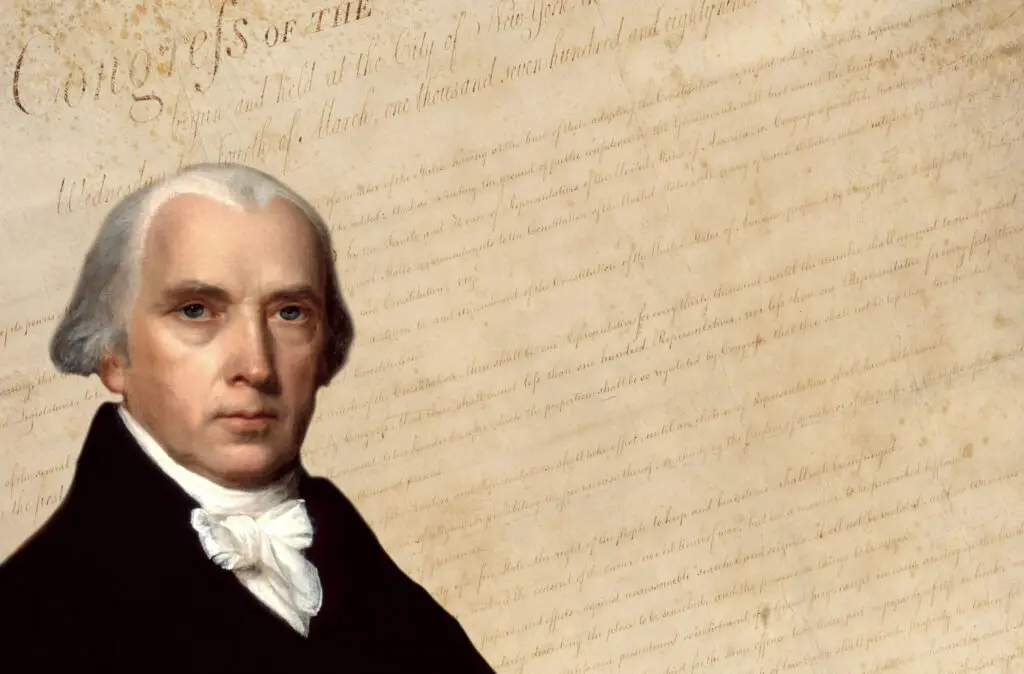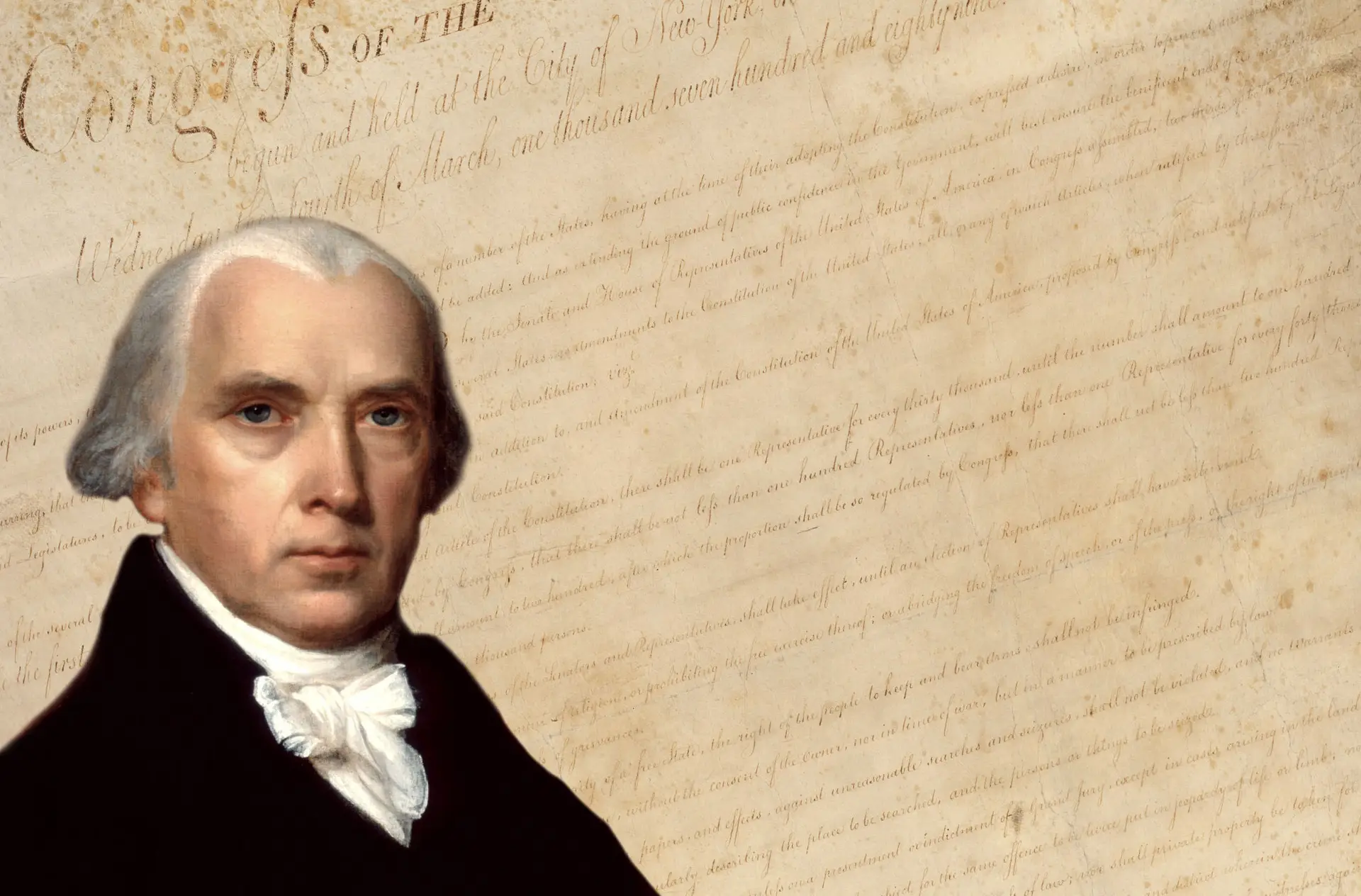
A Story of The Bill of Rights
Four years after the American War of Independence, James Madison was getting ready to attend the Constitutional Convention as one of Virginia’s delegates. The delegates were meeting to talk about how to improve the Articles of Confederation, which were the first governing documents of the United States. These Articles had many weaknesses. They gave little power to the national government, making it hard to enforce laws, while still requiring it to do things like pay for an army without having enough money.
As he prepared for the Convention, Madison wrote an essay called “Vices of the Political System,” (1) which explained the problems with the Articles. He noticed how the majority of people in different states could cause significant problems for people in the minority. For example, if most people in a state followed one religion, they could treat those who practiced a different one unfairly.
He also noted how the reverse could be true, too. He recognized that if too much power was in a small group, they might not do what most people wanted. He considered that without restrictions, the government could become tyrannical, oppressing those who were different in beliefs, ideas, or even appearance.(2)
During the debates to create the new Constitution, Madison took notes on the different arguments. He also made several arguments of his own. He helped find a solution for almost every problem discussed at the Convention.
He was a strong supporter of important ideas like the separation of powers, having two houses in Congress, checks and balances between the three branches of government, and federalism, which helps protect individual rights by sharing power with the states.
On September 12, towards the end of the Convention, another Virginia delegate, George Mason, suggested a Bill of Rights that would help protect the people. Virginia already had a Bill of Rights, which he based his proposal on.(3) George believed the bill should list the rights that people have, which the government cannot take away. Many agreed with him, but as the Convention was finishing up, they were worried about debating this for too long, so they decided not to accept his proposal.
At first, Madison was against the Bill of Rights because he thought it would spoil the Constitution he had worked hard to create. He argued in Federalist No. 10 that a large republic would have many competing groups, which would naturally help protect the rights of minorities.(4) Nevertheless, as James saw the anti-federalists pushing for changes to the federal government, he started to believe differently. He saw that a large group of people could force changes in the laws that might negatively affect others. He started to see the benefit of general protections for the people in a Bill of Rights.
As he ran to become a Representative from Virginia, Madison promised to support a national Bill of Rights. After winning the election, he worked hard to keep this promise.
Most of the first Congress concentrated on organizing the new government, including figuring out how it would operate, raise money, and make treaties with other nations. James Madison took part in these efforts but remained focused on creating amendments that would protect people’s rights.
In June of 1789, Madison spoke on the House floor about why these amendments were needed. He explained that a Bill of Rights would help create peace among the opposing parties and promote justice in three main ways:
- Rhode Island and North Carolina, which had not yet approved the Constitution, would be fully welcomed into the United States.
- A Bill of Rights would help ease the worries of the anti-federalists about the government and show them the principles of friendship and fairness promoted by the federalists.
- Most importantly, the Bill of Rights would clearly state the important rights of people as protected by the Constitution.(5)
A committee was formed to gather all the suggested amendments from each state. They focused only on proposed amendments that would protect individual freedoms, not those that changed how the Constitution worked. Madison made a list of 19 amendments and a preamble for the Bill of Rights.
The Senate made changes and by September 14, 1789, the Bill of Rights was ready to be sent to the states. Although the President cannot create amendments, George Washington supported them and sent them to the states for approval on October 2. (6) By December 1791, all the states had ratified 10 of these amendments, which we now know as the Bill of Rights.
What happened to the other two proposed amendments?
The eleventh and twelfth amendments were actually the first and second amendments proposed.(7) The first suggested how many people each representative should represent. In the early days of the United States, this idea made sense because the population was small. Thankfully, it wasn’t ratified because Congress would have over 6,000 members today! Luckily, we have a smaller, more manageable number of 435 representatives.
The second proposed amendment was eventually ratified. It became the 27th amendment in 1992. (8) This amendment is about Congress changing its pay. It requires that if Congress wants to give itself a raise, an election must happen first. This way, the people can vote out any representative they do not like. This amendment took over 200 years for ratification, the longest in history. New amendments now have time limits for ratification. (9)
The Constitution and the Bill of Rights, which protect our rights from government intrusion, are truly remarkable. They have supported our nation and our freedoms for over 200 years. In our Give Me Liberty program, we teach students what each amendment means and how they can protect their rights. If you’d like to see more about our Give Me Liberty program, and take part in it with your own children, just click here:
Read More About Give Me Liberty Here.
1-Read a copy of the essay with critique and expansion by editors of the National Archives: https://founders.archives.gov/documents/Madison/01-09-02-0187
2- Read sections 6, 9 10, 11 of the essay
3- Virginia’s Bill of Rights: https://www.archives.gov/founding-docs/virginia-declaration-of-rights
4- Paragraph 11 is particularly noted: https://founders.archives.gov/documents/Madison/01-10-02-0178
5- Madison’s speech: https://founders.archives.gov/documents/Madison/01-12-02-0126
6- George Washington’s Circular to the Governors of the States, October 2, 1789 https://founders.archives.gov/documents/Washington/05-04-02-0087 Here is a brief outline of the whole process, too: https://www.archives.gov/founding-docs/bill-of-rights/how-did-it-happen
7- https://www.archives.gov/founding-docs/bill-of-rights-transcript
8- For an interesting read of the history of the 27th amendment: https://constitutioncenter.org/the-constitution/amendments/amendment-xxvii/interpretations/165
9- Although Congress is not required to create a time limit, they have proposed one on every proposed amendment since 1917, excepting for the amendment which would become the 19th amendment. Here is a Supreme Court case opinion confirming Congress has the right to enact a time limit: Dillon v. Gloss, Decided May 1921, pg. 376: https://tile.loc.gov/storage-services/service/ll/usrep/usrep256/usrep256368/usrep256368.pdf
Here is a brief article about time limits on amendment proposals in general: https://constitution.congress.gov/browse/essay/artV-4-2-1/ALDE_00013054/#ALDF_00017991

